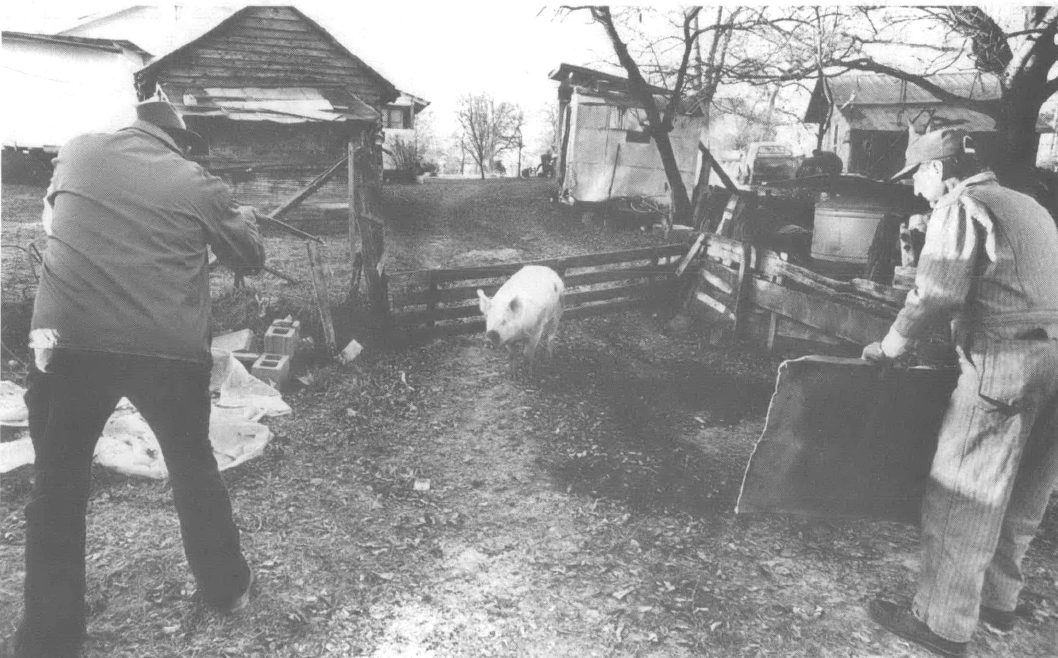
This article originally appeared in Southern Exposure Vol. 6 No. 3, "Passing Glances." Find more from that issue here.
Separated from his brothers and cornered in the backyard, the pig raises his dull stare to the man with the rifle. At the sharp crack of the .22 — always one shot, always between the eyes — the dying hog drops to its knees. Within seconds another man “sticks him” with a knife and a hot red fountain of blood spurts from the pig’s throat. The man moves quickly, for at this last wound the large animal thrashes and flails its powerful hooves in a final paroxysm of death. As soon as the carcass lies still, a board is tied to its rear legs and the two men drag the dead weight up the hill to where clouds of pungent vapor rise from a vat of water and lime.
So begins another hog-killing on Dale Rowland’s small Carolina Piedmont farm. The 76- year-old Mr. Rowland first slaughtered a pig himself at the age of 10 on his father’s farm and has raised them on his own farm for over 60 years. His initial taste of pork came as an infant when a strip of boiled fat meat was tied to his wrist for him to suckle. Today Mr. Rowland says that if he did not eat pork at least once a day, if not twice, he would ’‘perish to death.” And this daily meat must be pork, for Mr. Rowland states bluntly, “Beef will kill you.”
Dale Rowland and his wife, Leone, raised eleven children: to keep their larder full, they slaughtered about 35 hogs each winter — 10,000 pounds of pork. Today, with the children grown and scattered about the country, Mr. Rowland has slowed down some, but he still raises a number of the finest pigs he can manage. “It just won’t do to raise trash,” he says emphatically. He is quite proud of the quality and purity of the meat he raises.
The killing of the hogs for home consumption takes place in December or January on “the shrinking of the moon.” According to the Rowlands, to slaughter the animals under “agrowing moon” risks hanging up hams that will not cure with lard that will not dry. Also, if the weather is too warm, the meat will rot — the bone marrow turning green — in the three weeks it takes for the curing salt to penetrate. On the other hand, if the weather is so bitterly cold that the meat freezes solid, it won’t “take the salt” and will spoil as it thaws.
On the morning of a killing, Mr. Rowland is in his yard well before dawn, stoking a small fire under the large vat. The mixture of water and lime it contains must be heated to precisely 155 degrees. A pig will not “pick pretty” if the temperature is too high. If placed in too hot a vat, the cadaver becomes rigid and the hair stiffens so that it must be shaved. Years of experience enable Mr. Rowland to simply stick a finger in the steaming liquid and pronounce it correct.
Shortly after sunrise, Mr. Rowland’s brother, several of his sons, and a couple neighbors arrive to help. It becomes quickly evident that all these men have gone through this chore many times. No one snaps any orders, for each man knows his work and goes to it. On many farms, hog-killing is a time for the men folk to bring out whiskey, but Mr. Rowland allows no drinking or cursing here. He says, “I never heard tell of anyone getting hurt at this less they were drunk. Now, I ain’t so good myself, but I believe in doing right.”
Within minutes of being shot and stuck, the dead hog is lowered with chains into the vat and turned slowly, bobbing about like a trapped white whale. Shortly, the steaming pig is pulled from the vat. Next the men use either knives or the sharp edge of zinc canning lids to scrape the hair off the body. Once cleaned, a cut is made behind the heel strings and the pig is hung head down beneath a set of forks. The suspended animal is then gutted. The liver and lights (lungs), which are used in sausage, are separated from the intestines. The kidneys are thrown to the dogs since “all the poison is in the kidneys.”
The intestines are taken into a shed where Leone Rowland, her sister and several neighbor women wait to begin their odorous tasks. The great lengths of gut are trimmed, cut, washed, turned inside out, skinned and washed again to become raw chitlins. The fat meat must be cut into chunks and the lard boiled down. Sausage is made with selected scraps, pepper, sage and salt.
Ask Dale Rowland whether the men or the women have the easier chores and he’ll answer, “There ain’t nothing easy in it.” Leone Rowland mentions that, though the men’s work is harder and heavier, the women’s work takes longer.
The gutted carcass will hang from the forks until the blood has drained, usually overnight. It is also important that the animal heat dissipate before the meat is carved and packed in salt. Carving must leave the meat “smooth and pretty” so insects won’t have any folds to hide in. If bugs do infest the meat, entire hams can be eaten out, leaving nothing but the bone hanging in a hollow casing of skin.
Ten pounds of salt are used for every hundred pounds of pork and a pound of sugar is mixed with every ten pounds of the salt to sweeten the taste. The salted hams, shoulders and sidemeat are placed on shelves in the smokehouse to ensure an adequate flow of air during the curing. After the meat has thoroughly “taken the salt,” it is washed and coated with a mixture of black pepper and molasses. The meat is edible at this point, but is not considered fully cured until it has hung in the smokehouse some eight or nine months.
As Mr. Rowland tells visitors, “No matter what, we’re going to have something to eat.’’
Tags
Jackson Hill
Jackson Hill is a New Orleans photographer and longtime contributor to Southern Exposure. (1986)

